Sociology Assignment: NAPLAN Tests, Teachers, and Australian Education
VerifiedAdded on 2022/12/30
|23
|7020
|3
Essay
AI Summary
This sociology essay analyzes the National Assessment Program – Literacy and Numeracy (NAPLAN) tests in Australian schools, focusing on the perspectives of teachers. The essay explores the aims of NAPLAN, its components, and the debates surrounding its impact on the education system. It examines how NAPLAN influences the curriculum, leading to a narrowed focus on test-related content and potentially neglecting other important aspects of learning. The study also investigates the impact on teaching methods, or pedagogy, and how teachers may feel restricted in their approaches due to the pressure to achieve high test scores. Furthermore, the essay reviews literature on the effects of high-stakes testing, particularly from the teachers' point of view, and how this may affect students, especially those from disadvantaged backgrounds. It emphasizes the potential for the policy to reduce creativity, engagement, and overall student achievements, highlighting the need for a balanced approach that considers the broader goals of education beyond standardized testing.
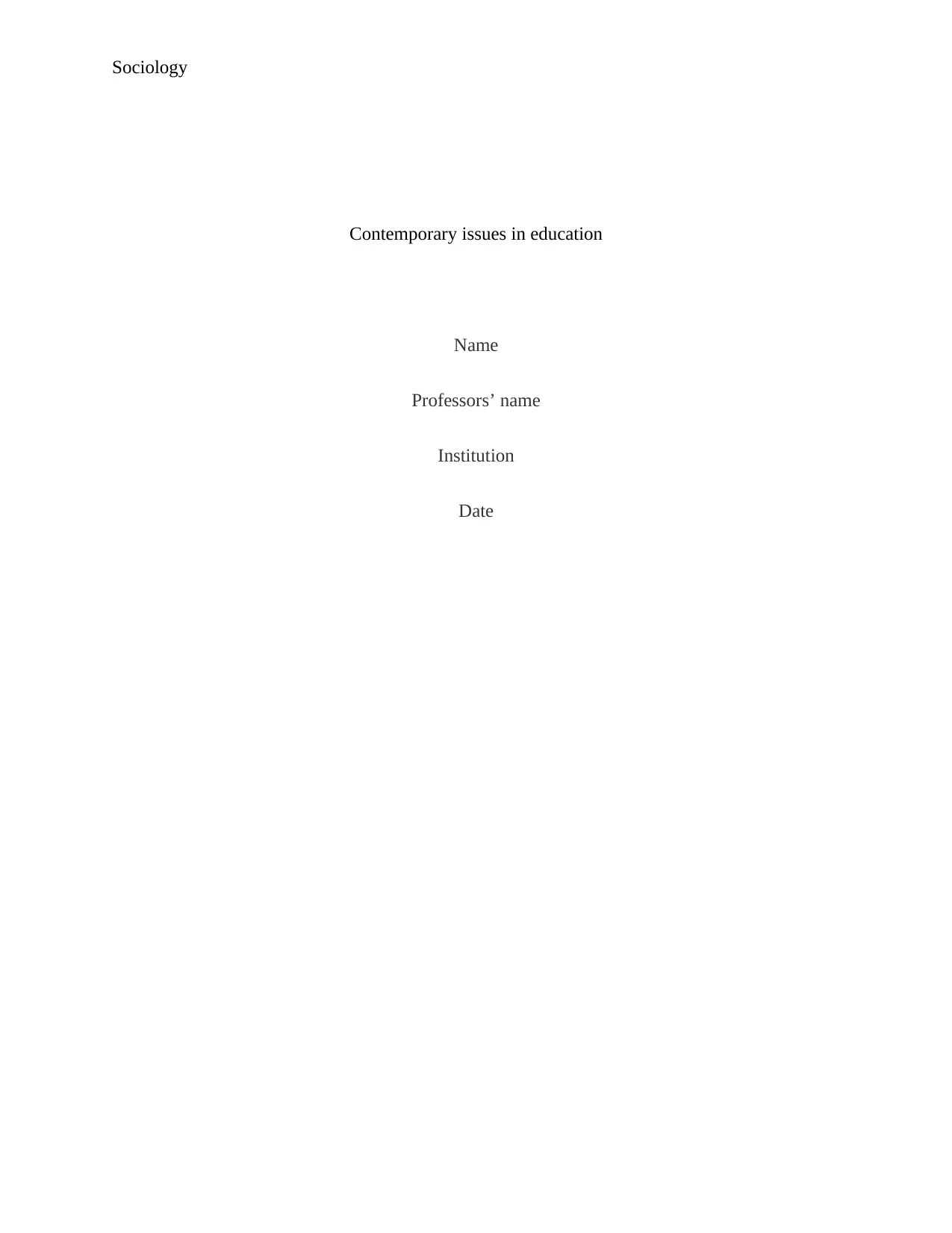
Sociology
Contemporary issues in education
Name
Professors’ name
Institution
Date
Contemporary issues in education
Name
Professors’ name
Institution
Date
Paraphrase This Document
Need a fresh take? Get an instant paraphrase of this document with our AI Paraphraser
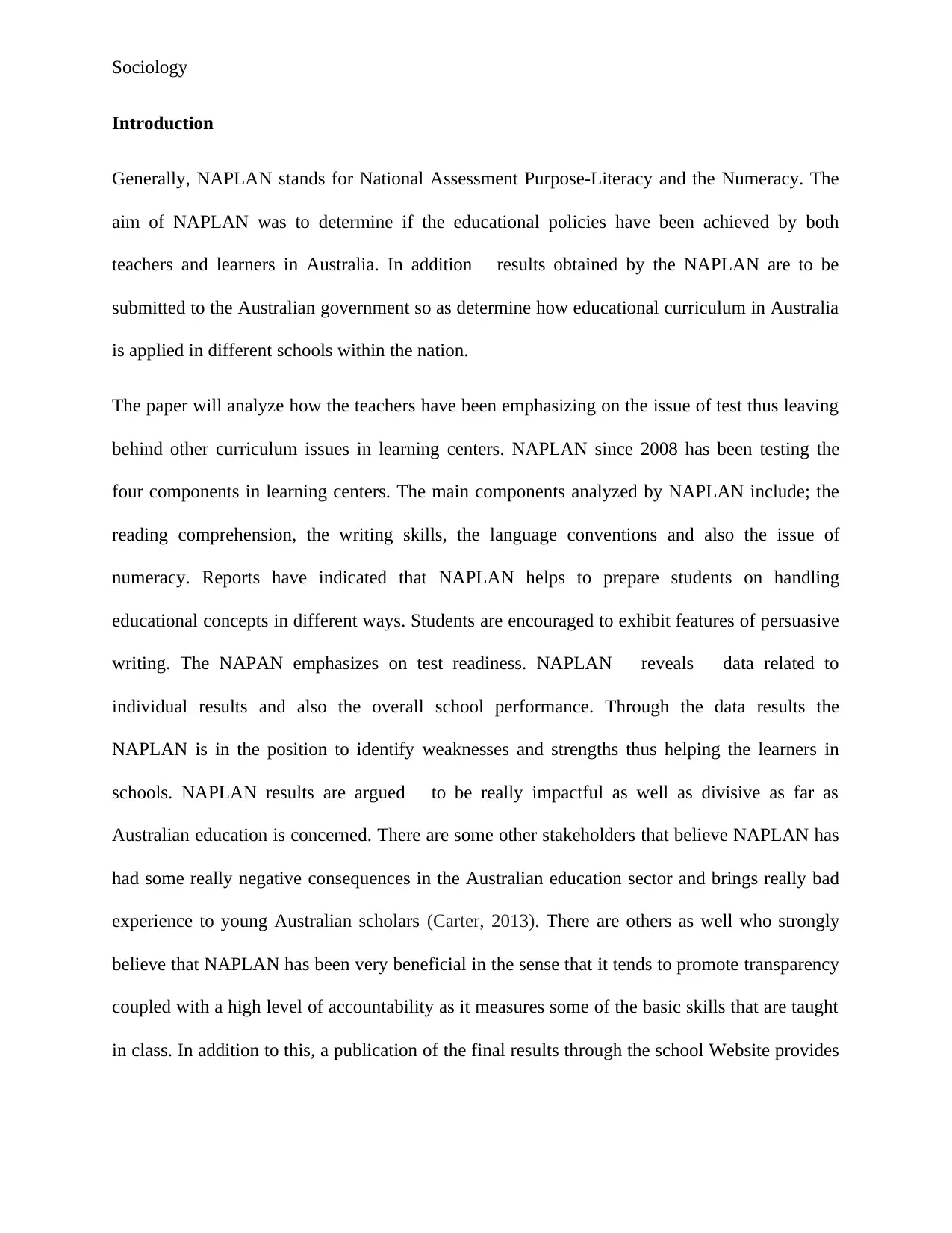
Sociology
Introduction
Generally, NAPLAN stands for National Assessment Purpose-Literacy and the Numeracy. The
aim of NAPLAN was to determine if the educational policies have been achieved by both
teachers and learners in Australia. In addition results obtained by the NAPLAN are to be
submitted to the Australian government so as determine how educational curriculum in Australia
is applied in different schools within the nation.
The paper will analyze how the teachers have been emphasizing on the issue of test thus leaving
behind other curriculum issues in learning centers. NAPLAN since 2008 has been testing the
four components in learning centers. The main components analyzed by NAPLAN include; the
reading comprehension, the writing skills, the language conventions and also the issue of
numeracy. Reports have indicated that NAPLAN helps to prepare students on handling
educational concepts in different ways. Students are encouraged to exhibit features of persuasive
writing. The NAPAN emphasizes on test readiness. NAPLAN reveals data related to
individual results and also the overall school performance. Through the data results the
NAPLAN is in the position to identify weaknesses and strengths thus helping the learners in
schools. NAPLAN results are argued to be really impactful as well as divisive as far as
Australian education is concerned. There are some other stakeholders that believe NAPLAN has
had some really negative consequences in the Australian education sector and brings really bad
experience to young Australian scholars (Carter, 2013). There are others as well who strongly
believe that NAPLAN has been very beneficial in the sense that it tends to promote transparency
coupled with a high level of accountability as it measures some of the basic skills that are taught
in class. In addition to this, a publication of the final results through the school Website provides
Introduction
Generally, NAPLAN stands for National Assessment Purpose-Literacy and the Numeracy. The
aim of NAPLAN was to determine if the educational policies have been achieved by both
teachers and learners in Australia. In addition results obtained by the NAPLAN are to be
submitted to the Australian government so as determine how educational curriculum in Australia
is applied in different schools within the nation.
The paper will analyze how the teachers have been emphasizing on the issue of test thus leaving
behind other curriculum issues in learning centers. NAPLAN since 2008 has been testing the
four components in learning centers. The main components analyzed by NAPLAN include; the
reading comprehension, the writing skills, the language conventions and also the issue of
numeracy. Reports have indicated that NAPLAN helps to prepare students on handling
educational concepts in different ways. Students are encouraged to exhibit features of persuasive
writing. The NAPAN emphasizes on test readiness. NAPLAN reveals data related to
individual results and also the overall school performance. Through the data results the
NAPLAN is in the position to identify weaknesses and strengths thus helping the learners in
schools. NAPLAN results are argued to be really impactful as well as divisive as far as
Australian education is concerned. There are some other stakeholders that believe NAPLAN has
had some really negative consequences in the Australian education sector and brings really bad
experience to young Australian scholars (Carter, 2013). There are others as well who strongly
believe that NAPLAN has been very beneficial in the sense that it tends to promote transparency
coupled with a high level of accountability as it measures some of the basic skills that are taught
in class. In addition to this, a publication of the final results through the school Website provides
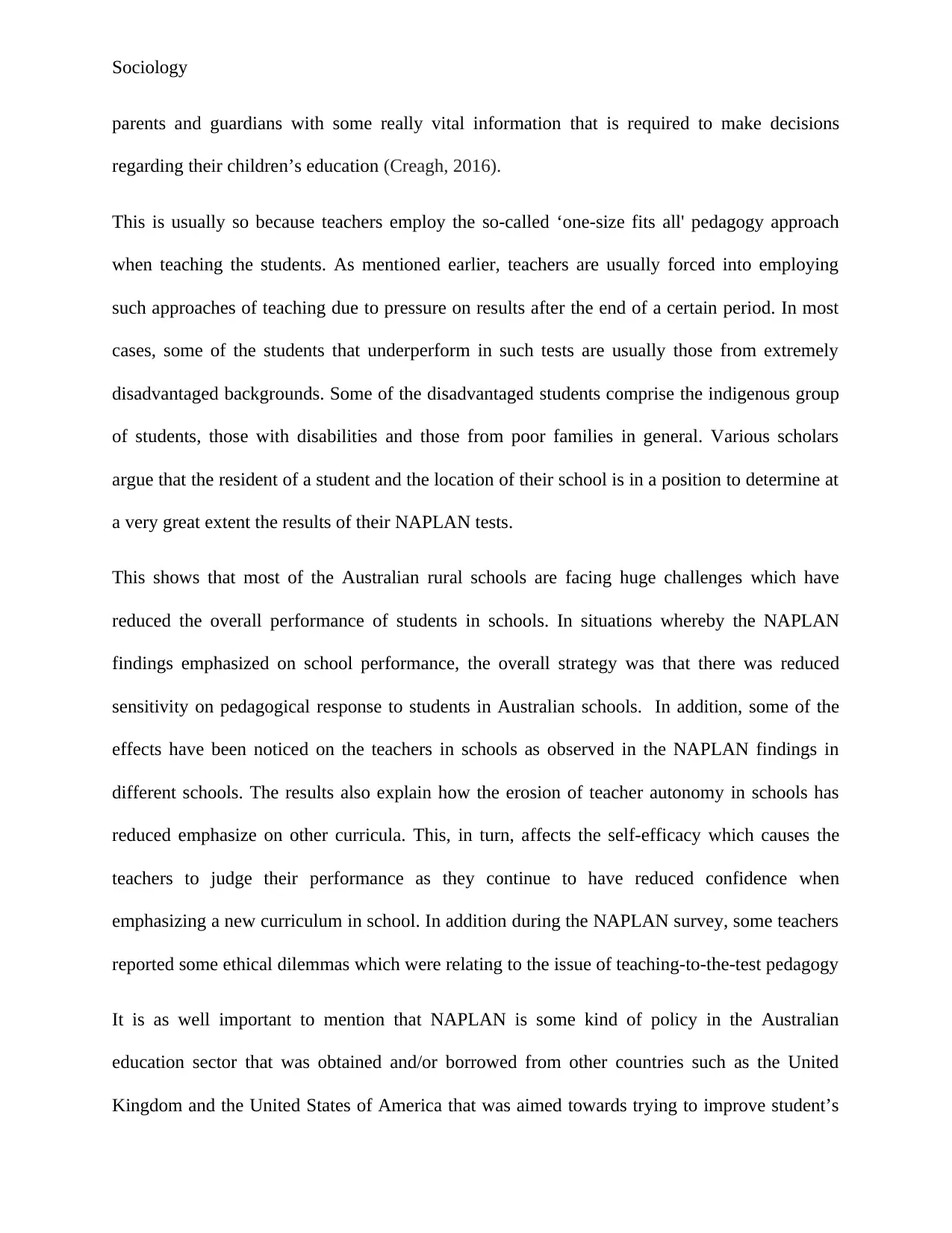
Sociology
parents and guardians with some really vital information that is required to make decisions
regarding their children’s education (Creagh, 2016).
This is usually so because teachers employ the so-called ‘one-size fits all' pedagogy approach
when teaching the students. As mentioned earlier, teachers are usually forced into employing
such approaches of teaching due to pressure on results after the end of a certain period. In most
cases, some of the students that underperform in such tests are usually those from extremely
disadvantaged backgrounds. Some of the disadvantaged students comprise the indigenous group
of students, those with disabilities and those from poor families in general. Various scholars
argue that the resident of a student and the location of their school is in a position to determine at
a very great extent the results of their NAPLAN tests.
This shows that most of the Australian rural schools are facing huge challenges which have
reduced the overall performance of students in schools. In situations whereby the NAPLAN
findings emphasized on school performance, the overall strategy was that there was reduced
sensitivity on pedagogical response to students in Australian schools. In addition, some of the
effects have been noticed on the teachers in schools as observed in the NAPLAN findings in
different schools. The results also explain how the erosion of teacher autonomy in schools has
reduced emphasize on other curricula. This, in turn, affects the self-efficacy which causes the
teachers to judge their performance as they continue to have reduced confidence when
emphasizing a new curriculum in school. In addition during the NAPLAN survey, some teachers
reported some ethical dilemmas which were relating to the issue of teaching-to-the-test pedagogy
It is as well important to mention that NAPLAN is some kind of policy in the Australian
education sector that was obtained and/or borrowed from other countries such as the United
Kingdom and the United States of America that was aimed towards trying to improve student’s
parents and guardians with some really vital information that is required to make decisions
regarding their children’s education (Creagh, 2016).
This is usually so because teachers employ the so-called ‘one-size fits all' pedagogy approach
when teaching the students. As mentioned earlier, teachers are usually forced into employing
such approaches of teaching due to pressure on results after the end of a certain period. In most
cases, some of the students that underperform in such tests are usually those from extremely
disadvantaged backgrounds. Some of the disadvantaged students comprise the indigenous group
of students, those with disabilities and those from poor families in general. Various scholars
argue that the resident of a student and the location of their school is in a position to determine at
a very great extent the results of their NAPLAN tests.
This shows that most of the Australian rural schools are facing huge challenges which have
reduced the overall performance of students in schools. In situations whereby the NAPLAN
findings emphasized on school performance, the overall strategy was that there was reduced
sensitivity on pedagogical response to students in Australian schools. In addition, some of the
effects have been noticed on the teachers in schools as observed in the NAPLAN findings in
different schools. The results also explain how the erosion of teacher autonomy in schools has
reduced emphasize on other curricula. This, in turn, affects the self-efficacy which causes the
teachers to judge their performance as they continue to have reduced confidence when
emphasizing a new curriculum in school. In addition during the NAPLAN survey, some teachers
reported some ethical dilemmas which were relating to the issue of teaching-to-the-test pedagogy
It is as well important to mention that NAPLAN is some kind of policy in the Australian
education sector that was obtained and/or borrowed from other countries such as the United
Kingdom and the United States of America that was aimed towards trying to improve student’s
⊘ This is a preview!⊘
Do you want full access?
Subscribe today to unlock all pages.

Trusted by 1+ million students worldwide
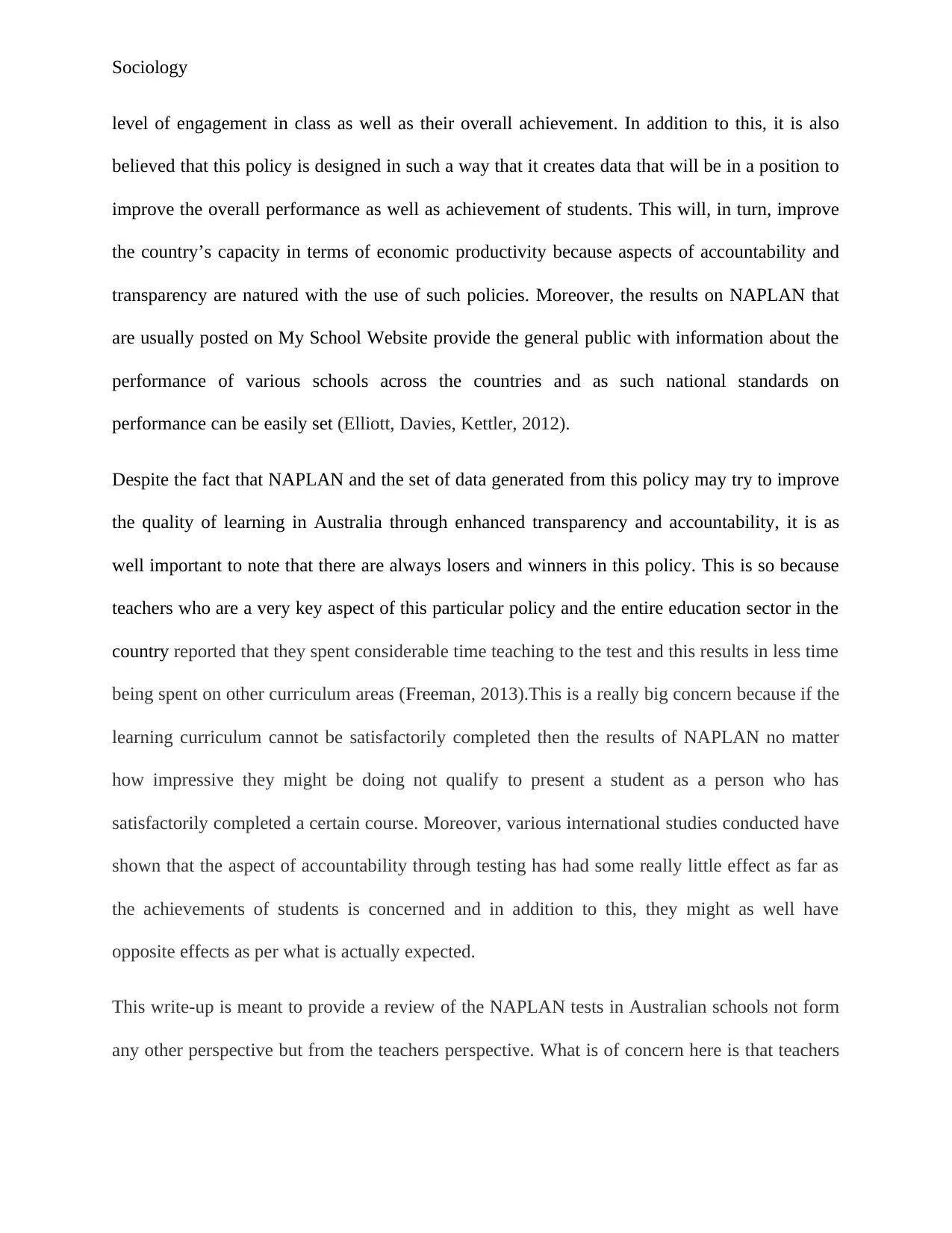
Sociology
level of engagement in class as well as their overall achievement. In addition to this, it is also
believed that this policy is designed in such a way that it creates data that will be in a position to
improve the overall performance as well as achievement of students. This will, in turn, improve
the country’s capacity in terms of economic productivity because aspects of accountability and
transparency are natured with the use of such policies. Moreover, the results on NAPLAN that
are usually posted on My School Website provide the general public with information about the
performance of various schools across the countries and as such national standards on
performance can be easily set (Elliott, Davies, Kettler, 2012).
Despite the fact that NAPLAN and the set of data generated from this policy may try to improve
the quality of learning in Australia through enhanced transparency and accountability, it is as
well important to note that there are always losers and winners in this policy. This is so because
teachers who are a very key aspect of this particular policy and the entire education sector in the
country reported that they spent considerable time teaching to the test and this results in less time
being spent on other curriculum areas (Freeman, 2013).This is a really big concern because if the
learning curriculum cannot be satisfactorily completed then the results of NAPLAN no matter
how impressive they might be doing not qualify to present a student as a person who has
satisfactorily completed a certain course. Moreover, various international studies conducted have
shown that the aspect of accountability through testing has had some really little effect as far as
the achievements of students is concerned and in addition to this, they might as well have
opposite effects as per what is actually expected.
This write-up is meant to provide a review of the NAPLAN tests in Australian schools not form
any other perspective but from the teachers perspective. What is of concern here is that teachers
level of engagement in class as well as their overall achievement. In addition to this, it is also
believed that this policy is designed in such a way that it creates data that will be in a position to
improve the overall performance as well as achievement of students. This will, in turn, improve
the country’s capacity in terms of economic productivity because aspects of accountability and
transparency are natured with the use of such policies. Moreover, the results on NAPLAN that
are usually posted on My School Website provide the general public with information about the
performance of various schools across the countries and as such national standards on
performance can be easily set (Elliott, Davies, Kettler, 2012).
Despite the fact that NAPLAN and the set of data generated from this policy may try to improve
the quality of learning in Australia through enhanced transparency and accountability, it is as
well important to note that there are always losers and winners in this policy. This is so because
teachers who are a very key aspect of this particular policy and the entire education sector in the
country reported that they spent considerable time teaching to the test and this results in less time
being spent on other curriculum areas (Freeman, 2013).This is a really big concern because if the
learning curriculum cannot be satisfactorily completed then the results of NAPLAN no matter
how impressive they might be doing not qualify to present a student as a person who has
satisfactorily completed a certain course. Moreover, various international studies conducted have
shown that the aspect of accountability through testing has had some really little effect as far as
the achievements of students is concerned and in addition to this, they might as well have
opposite effects as per what is actually expected.
This write-up is meant to provide a review of the NAPLAN tests in Australian schools not form
any other perspective but from the teachers perspective. What is of concern here is that teachers
Paraphrase This Document
Need a fresh take? Get an instant paraphrase of this document with our AI Paraphraser
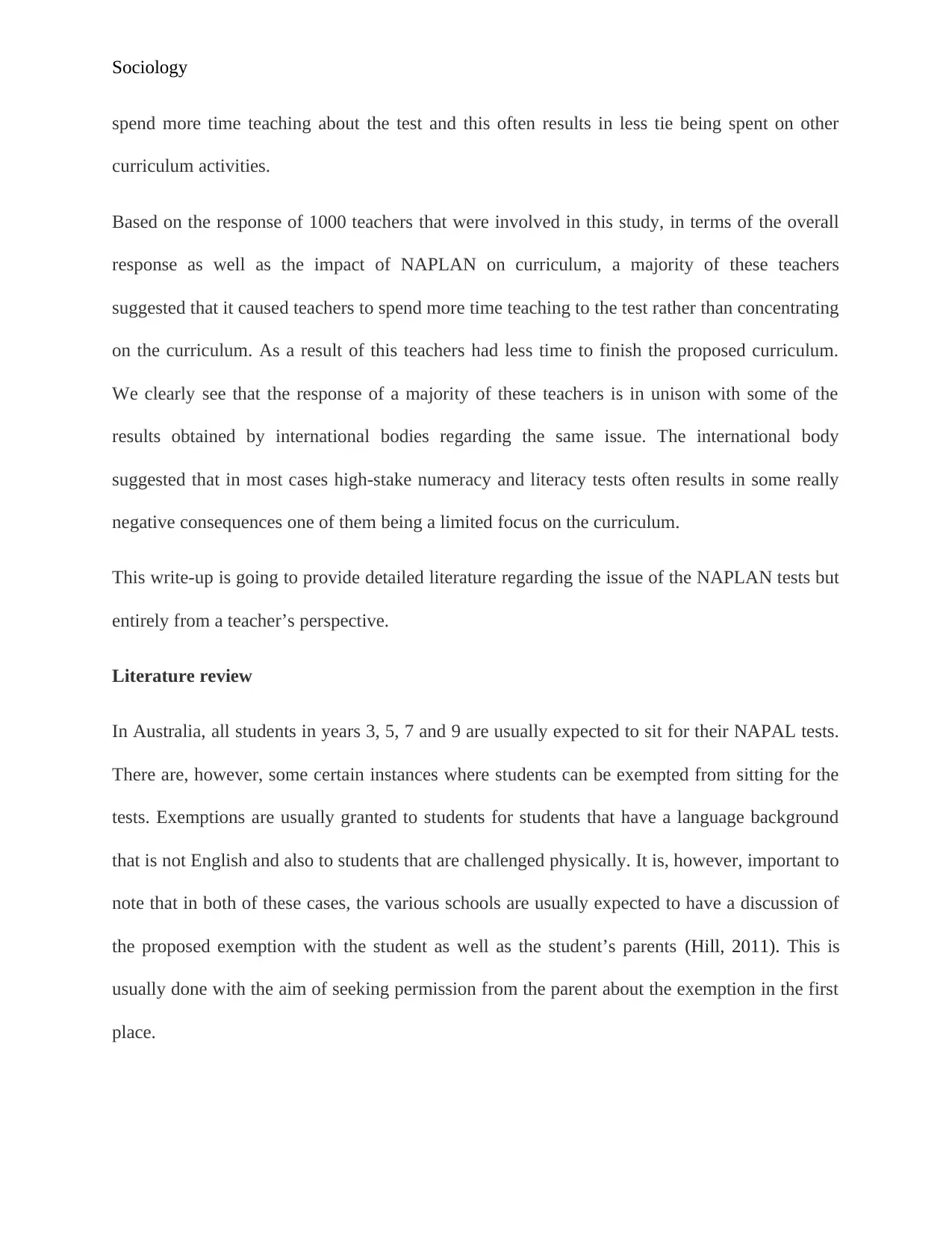
Sociology
spend more time teaching about the test and this often results in less tie being spent on other
curriculum activities.
Based on the response of 1000 teachers that were involved in this study, in terms of the overall
response as well as the impact of NAPLAN on curriculum, a majority of these teachers
suggested that it caused teachers to spend more time teaching to the test rather than concentrating
on the curriculum. As a result of this teachers had less time to finish the proposed curriculum.
We clearly see that the response of a majority of these teachers is in unison with some of the
results obtained by international bodies regarding the same issue. The international body
suggested that in most cases high-stake numeracy and literacy tests often results in some really
negative consequences one of them being a limited focus on the curriculum.
This write-up is going to provide detailed literature regarding the issue of the NAPLAN tests but
entirely from a teacher’s perspective.
Literature review
In Australia, all students in years 3, 5, 7 and 9 are usually expected to sit for their NAPAL tests.
There are, however, some certain instances where students can be exempted from sitting for the
tests. Exemptions are usually granted to students for students that have a language background
that is not English and also to students that are challenged physically. It is, however, important to
note that in both of these cases, the various schools are usually expected to have a discussion of
the proposed exemption with the student as well as the student’s parents (Hill, 2011). This is
usually done with the aim of seeking permission from the parent about the exemption in the first
place.
spend more time teaching about the test and this often results in less tie being spent on other
curriculum activities.
Based on the response of 1000 teachers that were involved in this study, in terms of the overall
response as well as the impact of NAPLAN on curriculum, a majority of these teachers
suggested that it caused teachers to spend more time teaching to the test rather than concentrating
on the curriculum. As a result of this teachers had less time to finish the proposed curriculum.
We clearly see that the response of a majority of these teachers is in unison with some of the
results obtained by international bodies regarding the same issue. The international body
suggested that in most cases high-stake numeracy and literacy tests often results in some really
negative consequences one of them being a limited focus on the curriculum.
This write-up is going to provide detailed literature regarding the issue of the NAPLAN tests but
entirely from a teacher’s perspective.
Literature review
In Australia, all students in years 3, 5, 7 and 9 are usually expected to sit for their NAPAL tests.
There are, however, some certain instances where students can be exempted from sitting for the
tests. Exemptions are usually granted to students for students that have a language background
that is not English and also to students that are challenged physically. It is, however, important to
note that in both of these cases, the various schools are usually expected to have a discussion of
the proposed exemption with the student as well as the student’s parents (Hill, 2011). This is
usually done with the aim of seeking permission from the parent about the exemption in the first
place.
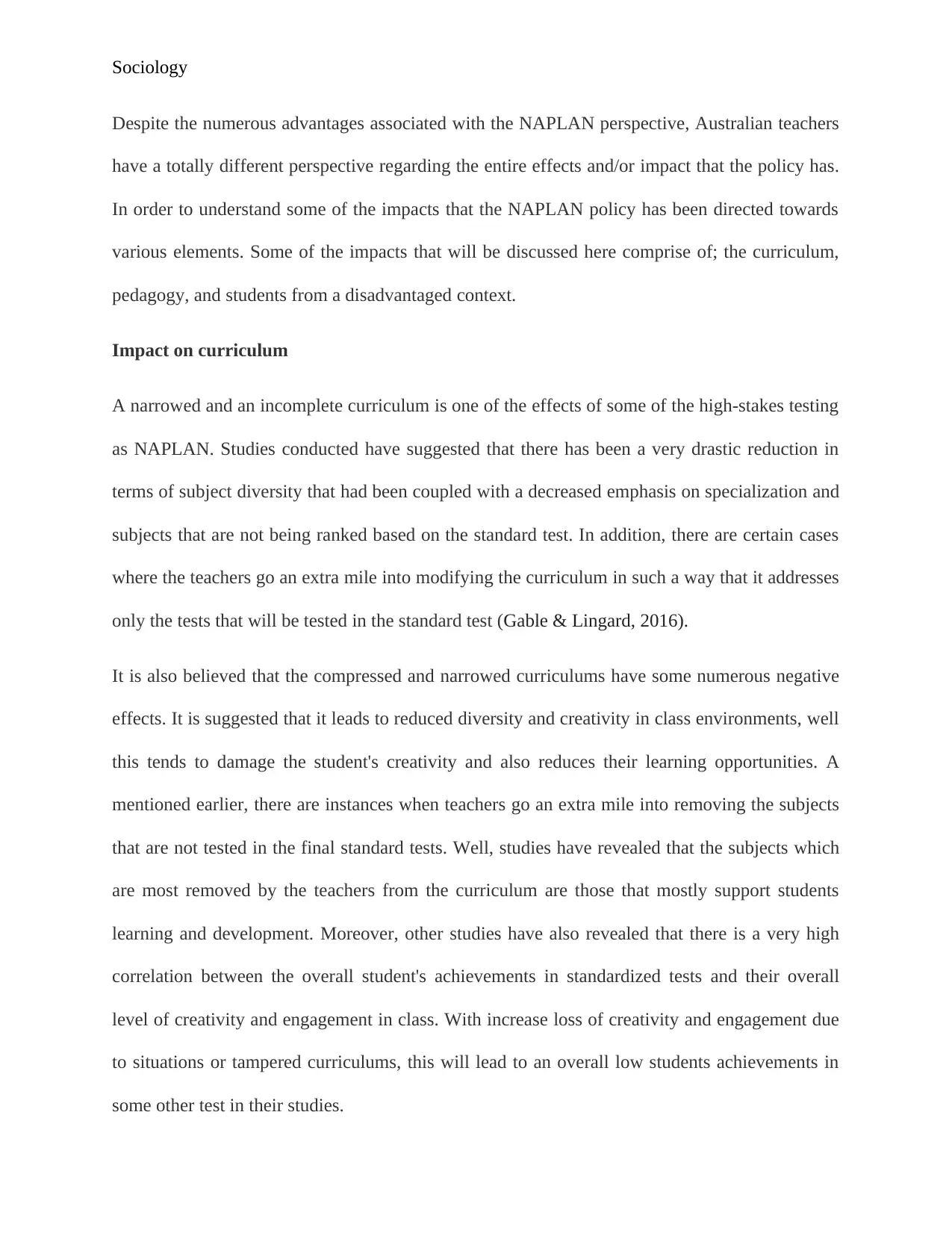
Sociology
Despite the numerous advantages associated with the NAPLAN perspective, Australian teachers
have a totally different perspective regarding the entire effects and/or impact that the policy has.
In order to understand some of the impacts that the NAPLAN policy has been directed towards
various elements. Some of the impacts that will be discussed here comprise of; the curriculum,
pedagogy, and students from a disadvantaged context.
Impact on curriculum
A narrowed and an incomplete curriculum is one of the effects of some of the high-stakes testing
as NAPLAN. Studies conducted have suggested that there has been a very drastic reduction in
terms of subject diversity that had been coupled with a decreased emphasis on specialization and
subjects that are not being ranked based on the standard test. In addition, there are certain cases
where the teachers go an extra mile into modifying the curriculum in such a way that it addresses
only the tests that will be tested in the standard test (Gable & Lingard, 2016).
It is also believed that the compressed and narrowed curriculums have some numerous negative
effects. It is suggested that it leads to reduced diversity and creativity in class environments, well
this tends to damage the student's creativity and also reduces their learning opportunities. A
mentioned earlier, there are instances when teachers go an extra mile into removing the subjects
that are not tested in the final standard tests. Well, studies have revealed that the subjects which
are most removed by the teachers from the curriculum are those that mostly support students
learning and development. Moreover, other studies have also revealed that there is a very high
correlation between the overall student's achievements in standardized tests and their overall
level of creativity and engagement in class. With increase loss of creativity and engagement due
to situations or tampered curriculums, this will lead to an overall low students achievements in
some other test in their studies.
Despite the numerous advantages associated with the NAPLAN perspective, Australian teachers
have a totally different perspective regarding the entire effects and/or impact that the policy has.
In order to understand some of the impacts that the NAPLAN policy has been directed towards
various elements. Some of the impacts that will be discussed here comprise of; the curriculum,
pedagogy, and students from a disadvantaged context.
Impact on curriculum
A narrowed and an incomplete curriculum is one of the effects of some of the high-stakes testing
as NAPLAN. Studies conducted have suggested that there has been a very drastic reduction in
terms of subject diversity that had been coupled with a decreased emphasis on specialization and
subjects that are not being ranked based on the standard test. In addition, there are certain cases
where the teachers go an extra mile into modifying the curriculum in such a way that it addresses
only the tests that will be tested in the standard test (Gable & Lingard, 2016).
It is also believed that the compressed and narrowed curriculums have some numerous negative
effects. It is suggested that it leads to reduced diversity and creativity in class environments, well
this tends to damage the student's creativity and also reduces their learning opportunities. A
mentioned earlier, there are instances when teachers go an extra mile into removing the subjects
that are not tested in the final standard tests. Well, studies have revealed that the subjects which
are most removed by the teachers from the curriculum are those that mostly support students
learning and development. Moreover, other studies have also revealed that there is a very high
correlation between the overall student's achievements in standardized tests and their overall
level of creativity and engagement in class. With increase loss of creativity and engagement due
to situations or tampered curriculums, this will lead to an overall low students achievements in
some other test in their studies.
⊘ This is a preview!⊘
Do you want full access?
Subscribe today to unlock all pages.

Trusted by 1+ million students worldwide
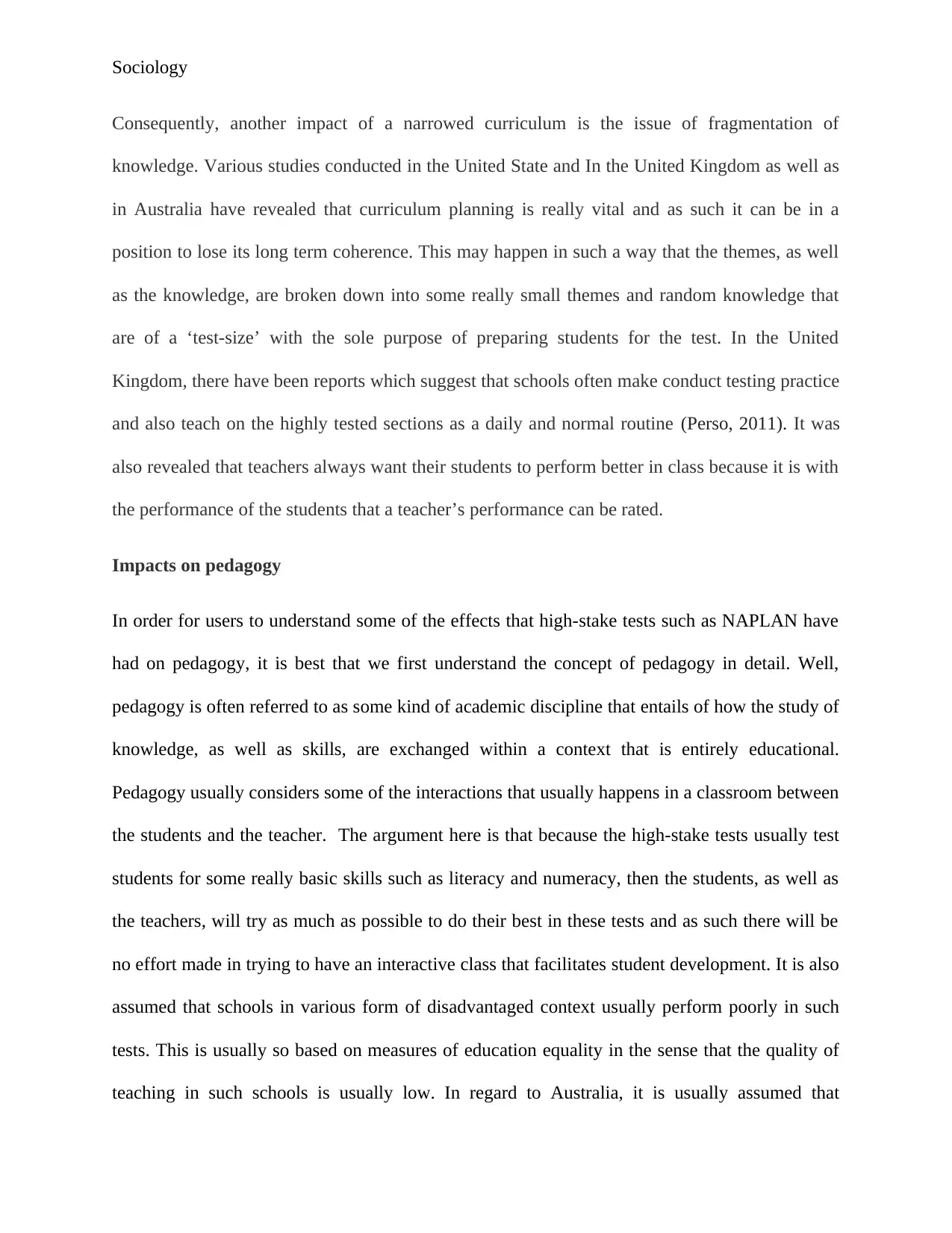
Sociology
Consequently, another impact of a narrowed curriculum is the issue of fragmentation of
knowledge. Various studies conducted in the United State and In the United Kingdom as well as
in Australia have revealed that curriculum planning is really vital and as such it can be in a
position to lose its long term coherence. This may happen in such a way that the themes, as well
as the knowledge, are broken down into some really small themes and random knowledge that
are of a ‘test-size’ with the sole purpose of preparing students for the test. In the United
Kingdom, there have been reports which suggest that schools often make conduct testing practice
and also teach on the highly tested sections as a daily and normal routine (Perso, 2011). It was
also revealed that teachers always want their students to perform better in class because it is with
the performance of the students that a teacher’s performance can be rated.
Impacts on pedagogy
In order for users to understand some of the effects that high-stake tests such as NAPLAN have
had on pedagogy, it is best that we first understand the concept of pedagogy in detail. Well,
pedagogy is often referred to as some kind of academic discipline that entails of how the study of
knowledge, as well as skills, are exchanged within a context that is entirely educational.
Pedagogy usually considers some of the interactions that usually happens in a classroom between
the students and the teacher. The argument here is that because the high-stake tests usually test
students for some really basic skills such as literacy and numeracy, then the students, as well as
the teachers, will try as much as possible to do their best in these tests and as such there will be
no effort made in trying to have an interactive class that facilitates student development. It is also
assumed that schools in various form of disadvantaged context usually perform poorly in such
tests. This is usually so based on measures of education equality in the sense that the quality of
teaching in such schools is usually low. In regard to Australia, it is usually assumed that
Consequently, another impact of a narrowed curriculum is the issue of fragmentation of
knowledge. Various studies conducted in the United State and In the United Kingdom as well as
in Australia have revealed that curriculum planning is really vital and as such it can be in a
position to lose its long term coherence. This may happen in such a way that the themes, as well
as the knowledge, are broken down into some really small themes and random knowledge that
are of a ‘test-size’ with the sole purpose of preparing students for the test. In the United
Kingdom, there have been reports which suggest that schools often make conduct testing practice
and also teach on the highly tested sections as a daily and normal routine (Perso, 2011). It was
also revealed that teachers always want their students to perform better in class because it is with
the performance of the students that a teacher’s performance can be rated.
Impacts on pedagogy
In order for users to understand some of the effects that high-stake tests such as NAPLAN have
had on pedagogy, it is best that we first understand the concept of pedagogy in detail. Well,
pedagogy is often referred to as some kind of academic discipline that entails of how the study of
knowledge, as well as skills, are exchanged within a context that is entirely educational.
Pedagogy usually considers some of the interactions that usually happens in a classroom between
the students and the teacher. The argument here is that because the high-stake tests usually test
students for some really basic skills such as literacy and numeracy, then the students, as well as
the teachers, will try as much as possible to do their best in these tests and as such there will be
no effort made in trying to have an interactive class that facilitates student development. It is also
assumed that schools in various form of disadvantaged context usually perform poorly in such
tests. This is usually so based on measures of education equality in the sense that the quality of
teaching in such schools is usually low. In regard to Australia, it is usually assumed that
Paraphrase This Document
Need a fresh take? Get an instant paraphrase of this document with our AI Paraphraser
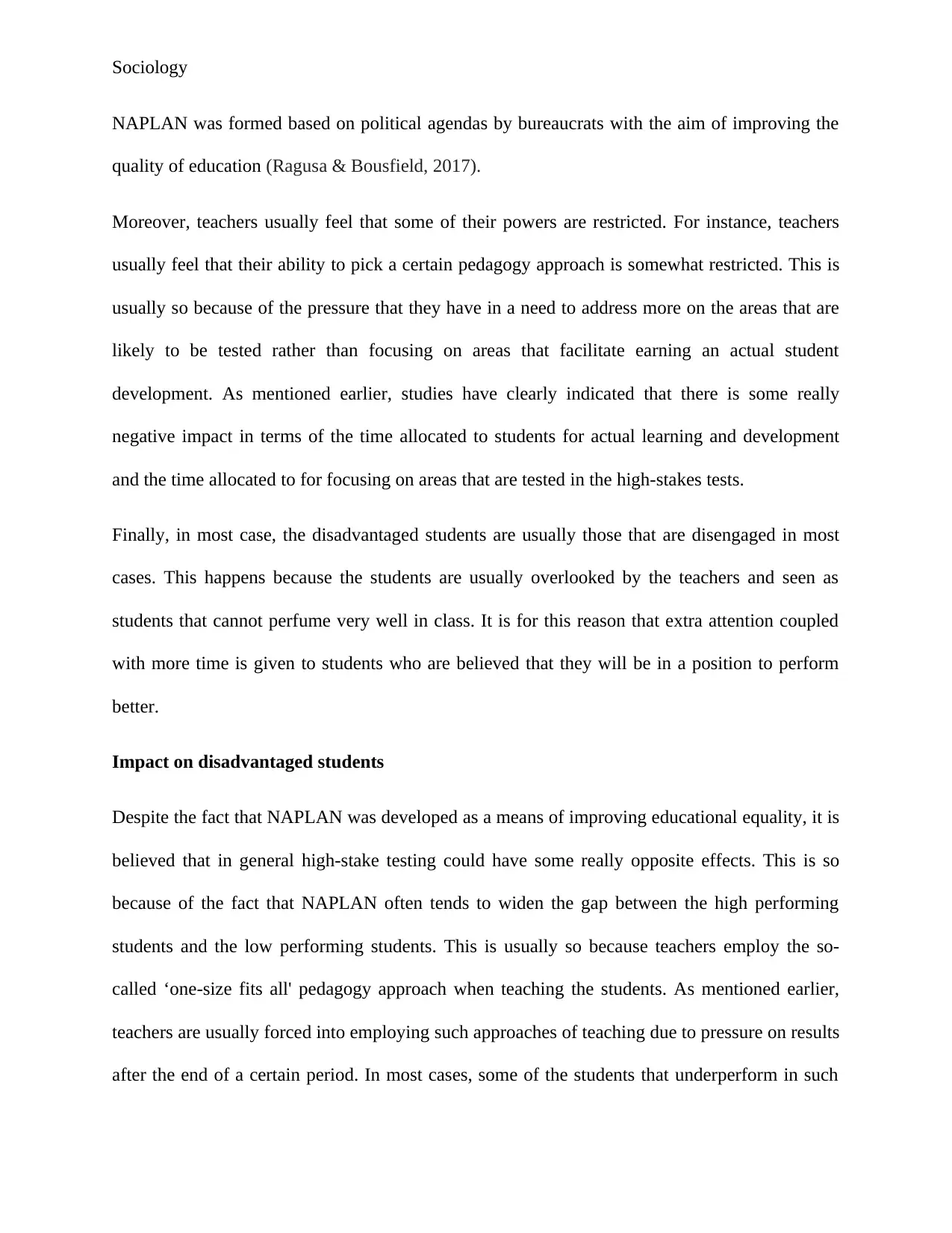
Sociology
NAPLAN was formed based on political agendas by bureaucrats with the aim of improving the
quality of education (Ragusa & Bousfield, 2017).
Moreover, teachers usually feel that some of their powers are restricted. For instance, teachers
usually feel that their ability to pick a certain pedagogy approach is somewhat restricted. This is
usually so because of the pressure that they have in a need to address more on the areas that are
likely to be tested rather than focusing on areas that facilitate earning an actual student
development. As mentioned earlier, studies have clearly indicated that there is some really
negative impact in terms of the time allocated to students for actual learning and development
and the time allocated to for focusing on areas that are tested in the high-stakes tests.
Finally, in most case, the disadvantaged students are usually those that are disengaged in most
cases. This happens because the students are usually overlooked by the teachers and seen as
students that cannot perfume very well in class. It is for this reason that extra attention coupled
with more time is given to students who are believed that they will be in a position to perform
better.
Impact on disadvantaged students
Despite the fact that NAPLAN was developed as a means of improving educational equality, it is
believed that in general high-stake testing could have some really opposite effects. This is so
because of the fact that NAPLAN often tends to widen the gap between the high performing
students and the low performing students. This is usually so because teachers employ the so-
called ‘one-size fits all' pedagogy approach when teaching the students. As mentioned earlier,
teachers are usually forced into employing such approaches of teaching due to pressure on results
after the end of a certain period. In most cases, some of the students that underperform in such
NAPLAN was formed based on political agendas by bureaucrats with the aim of improving the
quality of education (Ragusa & Bousfield, 2017).
Moreover, teachers usually feel that some of their powers are restricted. For instance, teachers
usually feel that their ability to pick a certain pedagogy approach is somewhat restricted. This is
usually so because of the pressure that they have in a need to address more on the areas that are
likely to be tested rather than focusing on areas that facilitate earning an actual student
development. As mentioned earlier, studies have clearly indicated that there is some really
negative impact in terms of the time allocated to students for actual learning and development
and the time allocated to for focusing on areas that are tested in the high-stakes tests.
Finally, in most case, the disadvantaged students are usually those that are disengaged in most
cases. This happens because the students are usually overlooked by the teachers and seen as
students that cannot perfume very well in class. It is for this reason that extra attention coupled
with more time is given to students who are believed that they will be in a position to perform
better.
Impact on disadvantaged students
Despite the fact that NAPLAN was developed as a means of improving educational equality, it is
believed that in general high-stake testing could have some really opposite effects. This is so
because of the fact that NAPLAN often tends to widen the gap between the high performing
students and the low performing students. This is usually so because teachers employ the so-
called ‘one-size fits all' pedagogy approach when teaching the students. As mentioned earlier,
teachers are usually forced into employing such approaches of teaching due to pressure on results
after the end of a certain period. In most cases, some of the students that underperform in such
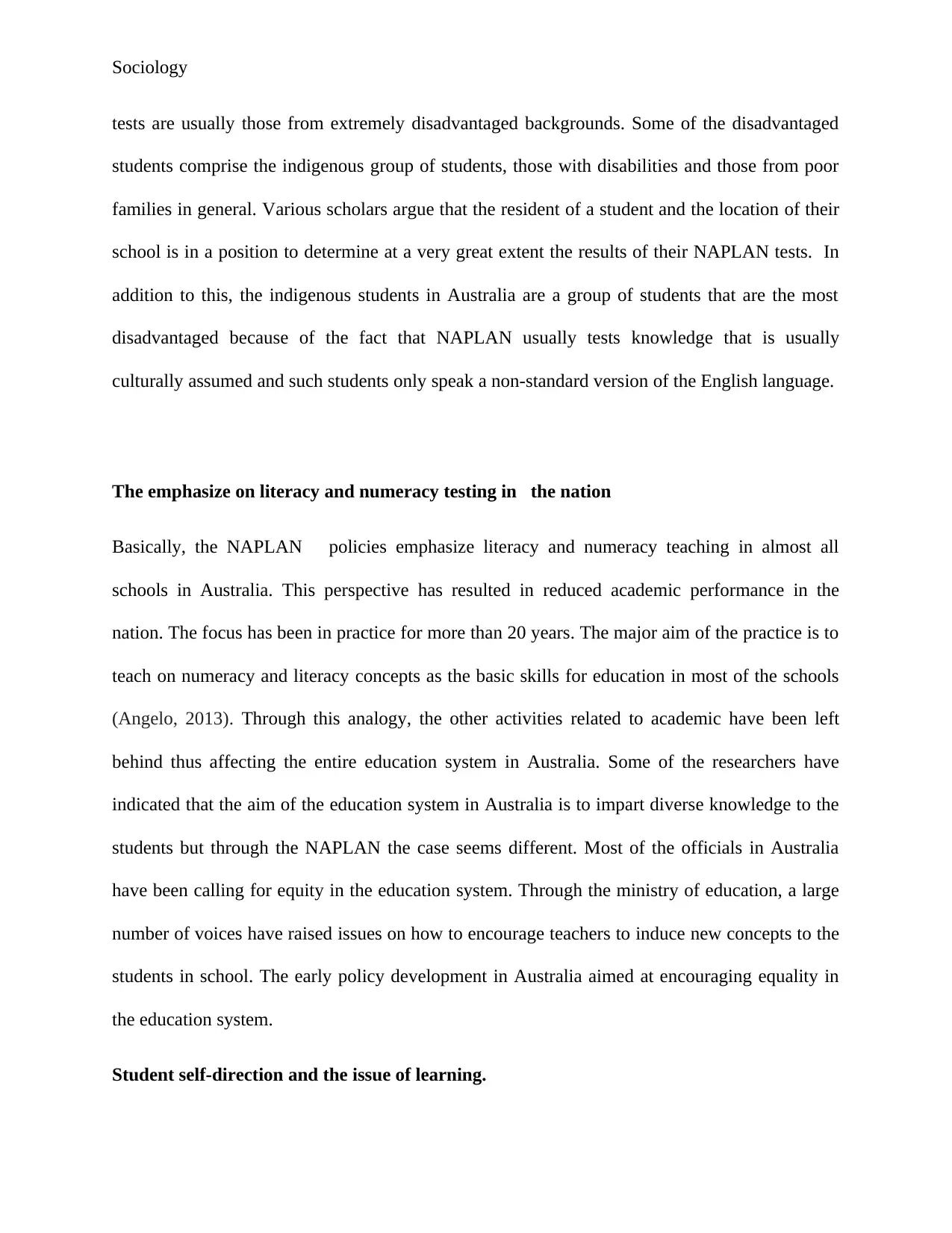
Sociology
tests are usually those from extremely disadvantaged backgrounds. Some of the disadvantaged
students comprise the indigenous group of students, those with disabilities and those from poor
families in general. Various scholars argue that the resident of a student and the location of their
school is in a position to determine at a very great extent the results of their NAPLAN tests. In
addition to this, the indigenous students in Australia are a group of students that are the most
disadvantaged because of the fact that NAPLAN usually tests knowledge that is usually
culturally assumed and such students only speak a non-standard version of the English language.
The emphasize on literacy and numeracy testing in the nation
Basically, the NAPLAN policies emphasize literacy and numeracy teaching in almost all
schools in Australia. This perspective has resulted in reduced academic performance in the
nation. The focus has been in practice for more than 20 years. The major aim of the practice is to
teach on numeracy and literacy concepts as the basic skills for education in most of the schools
(Angelo, 2013). Through this analogy, the other activities related to academic have been left
behind thus affecting the entire education system in Australia. Some of the researchers have
indicated that the aim of the education system in Australia is to impart diverse knowledge to the
students but through the NAPLAN the case seems different. Most of the officials in Australia
have been calling for equity in the education system. Through the ministry of education, a large
number of voices have raised issues on how to encourage teachers to induce new concepts to the
students in school. The early policy development in Australia aimed at encouraging equality in
the education system.
Student self-direction and the issue of learning.
tests are usually those from extremely disadvantaged backgrounds. Some of the disadvantaged
students comprise the indigenous group of students, those with disabilities and those from poor
families in general. Various scholars argue that the resident of a student and the location of their
school is in a position to determine at a very great extent the results of their NAPLAN tests. In
addition to this, the indigenous students in Australia are a group of students that are the most
disadvantaged because of the fact that NAPLAN usually tests knowledge that is usually
culturally assumed and such students only speak a non-standard version of the English language.
The emphasize on literacy and numeracy testing in the nation
Basically, the NAPLAN policies emphasize literacy and numeracy teaching in almost all
schools in Australia. This perspective has resulted in reduced academic performance in the
nation. The focus has been in practice for more than 20 years. The major aim of the practice is to
teach on numeracy and literacy concepts as the basic skills for education in most of the schools
(Angelo, 2013). Through this analogy, the other activities related to academic have been left
behind thus affecting the entire education system in Australia. Some of the researchers have
indicated that the aim of the education system in Australia is to impart diverse knowledge to the
students but through the NAPLAN the case seems different. Most of the officials in Australia
have been calling for equity in the education system. Through the ministry of education, a large
number of voices have raised issues on how to encourage teachers to induce new concepts to the
students in school. The early policy development in Australia aimed at encouraging equality in
the education system.
Student self-direction and the issue of learning.
⊘ This is a preview!⊘
Do you want full access?
Subscribe today to unlock all pages.

Trusted by 1+ million students worldwide
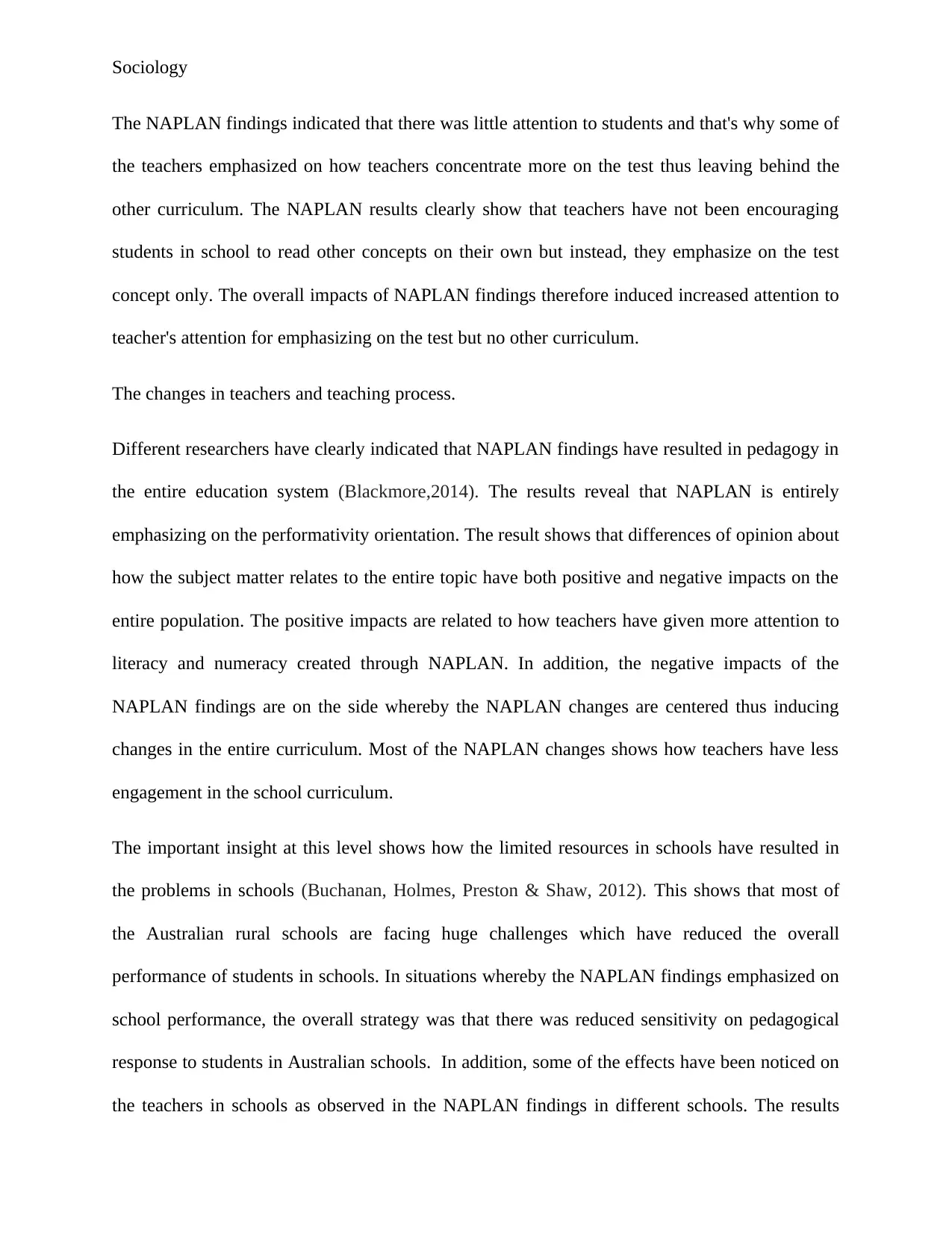
Sociology
The NAPLAN findings indicated that there was little attention to students and that's why some of
the teachers emphasized on how teachers concentrate more on the test thus leaving behind the
other curriculum. The NAPLAN results clearly show that teachers have not been encouraging
students in school to read other concepts on their own but instead, they emphasize on the test
concept only. The overall impacts of NAPLAN findings therefore induced increased attention to
teacher's attention for emphasizing on the test but no other curriculum.
The changes in teachers and teaching process.
Different researchers have clearly indicated that NAPLAN findings have resulted in pedagogy in
the entire education system (Blackmore,2014). The results reveal that NAPLAN is entirely
emphasizing on the performativity orientation. The result shows that differences of opinion about
how the subject matter relates to the entire topic have both positive and negative impacts on the
entire population. The positive impacts are related to how teachers have given more attention to
literacy and numeracy created through NAPLAN. In addition, the negative impacts of the
NAPLAN findings are on the side whereby the NAPLAN changes are centered thus inducing
changes in the entire curriculum. Most of the NAPLAN changes shows how teachers have less
engagement in the school curriculum.
The important insight at this level shows how the limited resources in schools have resulted in
the problems in schools (Buchanan, Holmes, Preston & Shaw, 2012). This shows that most of
the Australian rural schools are facing huge challenges which have reduced the overall
performance of students in schools. In situations whereby the NAPLAN findings emphasized on
school performance, the overall strategy was that there was reduced sensitivity on pedagogical
response to students in Australian schools. In addition, some of the effects have been noticed on
the teachers in schools as observed in the NAPLAN findings in different schools. The results
The NAPLAN findings indicated that there was little attention to students and that's why some of
the teachers emphasized on how teachers concentrate more on the test thus leaving behind the
other curriculum. The NAPLAN results clearly show that teachers have not been encouraging
students in school to read other concepts on their own but instead, they emphasize on the test
concept only. The overall impacts of NAPLAN findings therefore induced increased attention to
teacher's attention for emphasizing on the test but no other curriculum.
The changes in teachers and teaching process.
Different researchers have clearly indicated that NAPLAN findings have resulted in pedagogy in
the entire education system (Blackmore,2014). The results reveal that NAPLAN is entirely
emphasizing on the performativity orientation. The result shows that differences of opinion about
how the subject matter relates to the entire topic have both positive and negative impacts on the
entire population. The positive impacts are related to how teachers have given more attention to
literacy and numeracy created through NAPLAN. In addition, the negative impacts of the
NAPLAN findings are on the side whereby the NAPLAN changes are centered thus inducing
changes in the entire curriculum. Most of the NAPLAN changes shows how teachers have less
engagement in the school curriculum.
The important insight at this level shows how the limited resources in schools have resulted in
the problems in schools (Buchanan, Holmes, Preston & Shaw, 2012). This shows that most of
the Australian rural schools are facing huge challenges which have reduced the overall
performance of students in schools. In situations whereby the NAPLAN findings emphasized on
school performance, the overall strategy was that there was reduced sensitivity on pedagogical
response to students in Australian schools. In addition, some of the effects have been noticed on
the teachers in schools as observed in the NAPLAN findings in different schools. The results
Paraphrase This Document
Need a fresh take? Get an instant paraphrase of this document with our AI Paraphraser
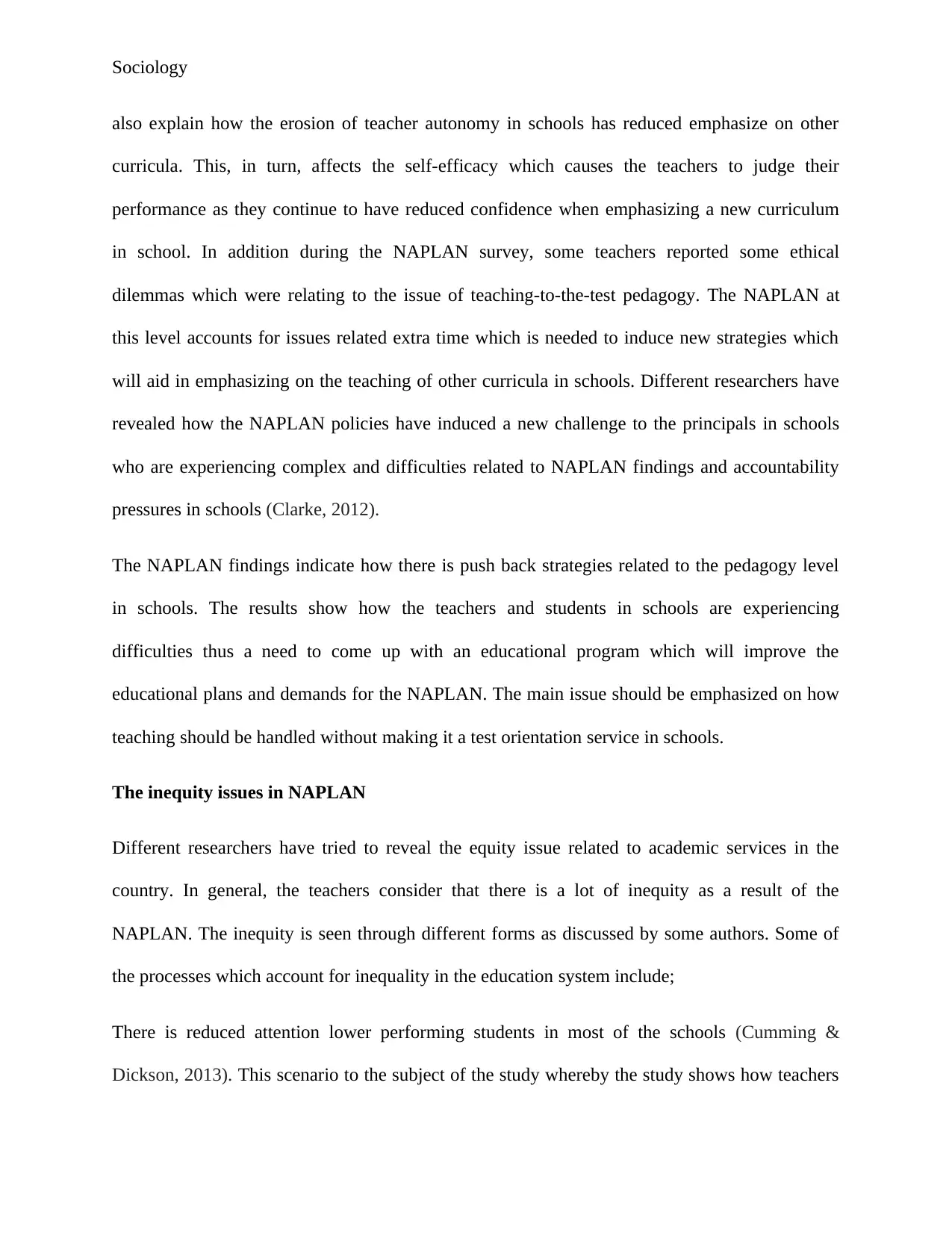
Sociology
also explain how the erosion of teacher autonomy in schools has reduced emphasize on other
curricula. This, in turn, affects the self-efficacy which causes the teachers to judge their
performance as they continue to have reduced confidence when emphasizing a new curriculum
in school. In addition during the NAPLAN survey, some teachers reported some ethical
dilemmas which were relating to the issue of teaching-to-the-test pedagogy. The NAPLAN at
this level accounts for issues related extra time which is needed to induce new strategies which
will aid in emphasizing on the teaching of other curricula in schools. Different researchers have
revealed how the NAPLAN policies have induced a new challenge to the principals in schools
who are experiencing complex and difficulties related to NAPLAN findings and accountability
pressures in schools (Clarke, 2012).
The NAPLAN findings indicate how there is push back strategies related to the pedagogy level
in schools. The results show how the teachers and students in schools are experiencing
difficulties thus a need to come up with an educational program which will improve the
educational plans and demands for the NAPLAN. The main issue should be emphasized on how
teaching should be handled without making it a test orientation service in schools.
The inequity issues in NAPLAN
Different researchers have tried to reveal the equity issue related to academic services in the
country. In general, the teachers consider that there is a lot of inequity as a result of the
NAPLAN. The inequity is seen through different forms as discussed by some authors. Some of
the processes which account for inequality in the education system include;
There is reduced attention lower performing students in most of the schools (Cumming &
Dickson, 2013). This scenario to the subject of the study whereby the study shows how teachers
also explain how the erosion of teacher autonomy in schools has reduced emphasize on other
curricula. This, in turn, affects the self-efficacy which causes the teachers to judge their
performance as they continue to have reduced confidence when emphasizing a new curriculum
in school. In addition during the NAPLAN survey, some teachers reported some ethical
dilemmas which were relating to the issue of teaching-to-the-test pedagogy. The NAPLAN at
this level accounts for issues related extra time which is needed to induce new strategies which
will aid in emphasizing on the teaching of other curricula in schools. Different researchers have
revealed how the NAPLAN policies have induced a new challenge to the principals in schools
who are experiencing complex and difficulties related to NAPLAN findings and accountability
pressures in schools (Clarke, 2012).
The NAPLAN findings indicate how there is push back strategies related to the pedagogy level
in schools. The results show how the teachers and students in schools are experiencing
difficulties thus a need to come up with an educational program which will improve the
educational plans and demands for the NAPLAN. The main issue should be emphasized on how
teaching should be handled without making it a test orientation service in schools.
The inequity issues in NAPLAN
Different researchers have tried to reveal the equity issue related to academic services in the
country. In general, the teachers consider that there is a lot of inequity as a result of the
NAPLAN. The inequity is seen through different forms as discussed by some authors. Some of
the processes which account for inequality in the education system include;
There is reduced attention lower performing students in most of the schools (Cumming &
Dickson, 2013). This scenario to the subject of the study whereby the study shows how teachers
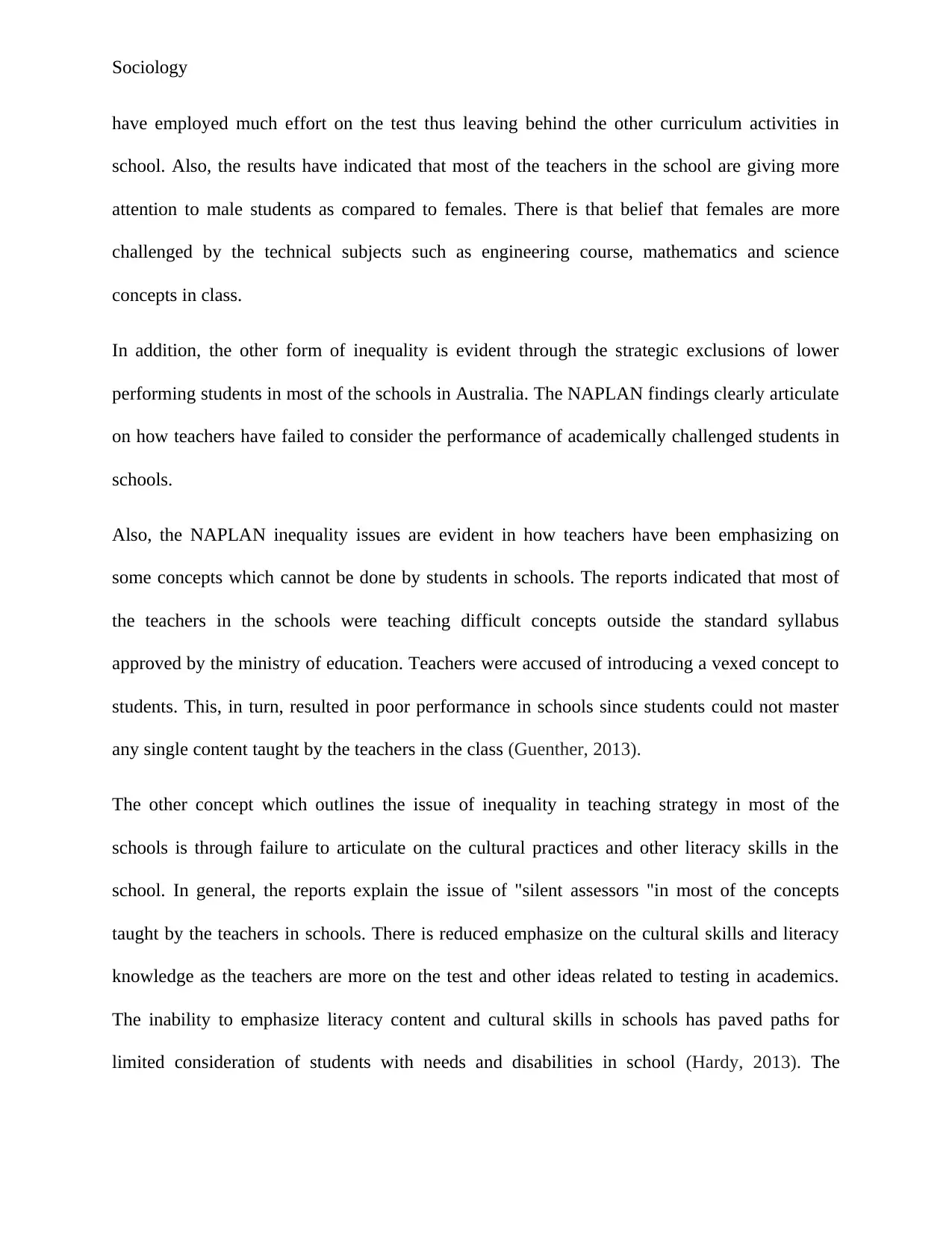
Sociology
have employed much effort on the test thus leaving behind the other curriculum activities in
school. Also, the results have indicated that most of the teachers in the school are giving more
attention to male students as compared to females. There is that belief that females are more
challenged by the technical subjects such as engineering course, mathematics and science
concepts in class.
In addition, the other form of inequality is evident through the strategic exclusions of lower
performing students in most of the schools in Australia. The NAPLAN findings clearly articulate
on how teachers have failed to consider the performance of academically challenged students in
schools.
Also, the NAPLAN inequality issues are evident in how teachers have been emphasizing on
some concepts which cannot be done by students in schools. The reports indicated that most of
the teachers in the schools were teaching difficult concepts outside the standard syllabus
approved by the ministry of education. Teachers were accused of introducing a vexed concept to
students. This, in turn, resulted in poor performance in schools since students could not master
any single content taught by the teachers in the class (Guenther, 2013).
The other concept which outlines the issue of inequality in teaching strategy in most of the
schools is through failure to articulate on the cultural practices and other literacy skills in the
school. In general, the reports explain the issue of "silent assessors "in most of the concepts
taught by the teachers in schools. There is reduced emphasize on the cultural skills and literacy
knowledge as the teachers are more on the test and other ideas related to testing in academics.
The inability to emphasize literacy content and cultural skills in schools has paved paths for
limited consideration of students with needs and disabilities in school (Hardy, 2013). The
have employed much effort on the test thus leaving behind the other curriculum activities in
school. Also, the results have indicated that most of the teachers in the school are giving more
attention to male students as compared to females. There is that belief that females are more
challenged by the technical subjects such as engineering course, mathematics and science
concepts in class.
In addition, the other form of inequality is evident through the strategic exclusions of lower
performing students in most of the schools in Australia. The NAPLAN findings clearly articulate
on how teachers have failed to consider the performance of academically challenged students in
schools.
Also, the NAPLAN inequality issues are evident in how teachers have been emphasizing on
some concepts which cannot be done by students in schools. The reports indicated that most of
the teachers in the schools were teaching difficult concepts outside the standard syllabus
approved by the ministry of education. Teachers were accused of introducing a vexed concept to
students. This, in turn, resulted in poor performance in schools since students could not master
any single content taught by the teachers in the class (Guenther, 2013).
The other concept which outlines the issue of inequality in teaching strategy in most of the
schools is through failure to articulate on the cultural practices and other literacy skills in the
school. In general, the reports explain the issue of "silent assessors "in most of the concepts
taught by the teachers in schools. There is reduced emphasize on the cultural skills and literacy
knowledge as the teachers are more on the test and other ideas related to testing in academics.
The inability to emphasize literacy content and cultural skills in schools has paved paths for
limited consideration of students with needs and disabilities in school (Hardy, 2013). The
⊘ This is a preview!⊘
Do you want full access?
Subscribe today to unlock all pages.

Trusted by 1+ million students worldwide
1 out of 23
Related Documents
Your All-in-One AI-Powered Toolkit for Academic Success.
+13062052269
info@desklib.com
Available 24*7 on WhatsApp / Email
![[object Object]](/_next/static/media/star-bottom.7253800d.svg)
Unlock your academic potential
Copyright © 2020–2025 A2Z Services. All Rights Reserved. Developed and managed by ZUCOL.





